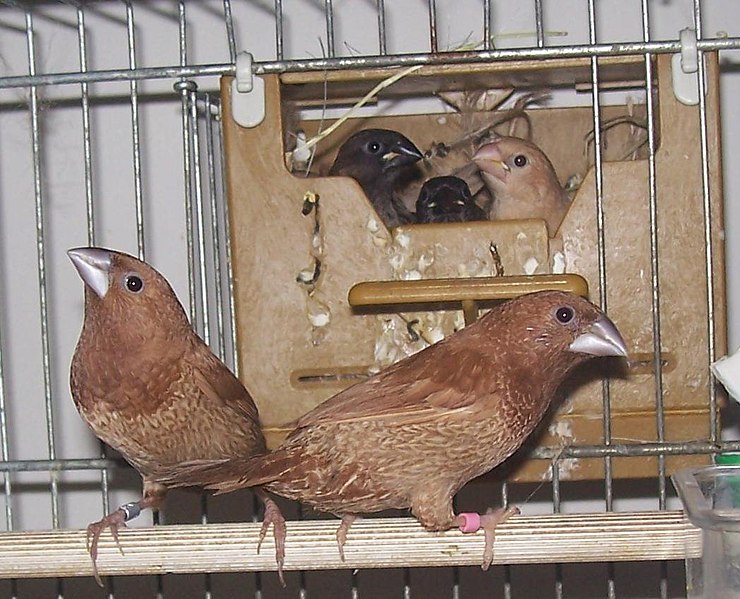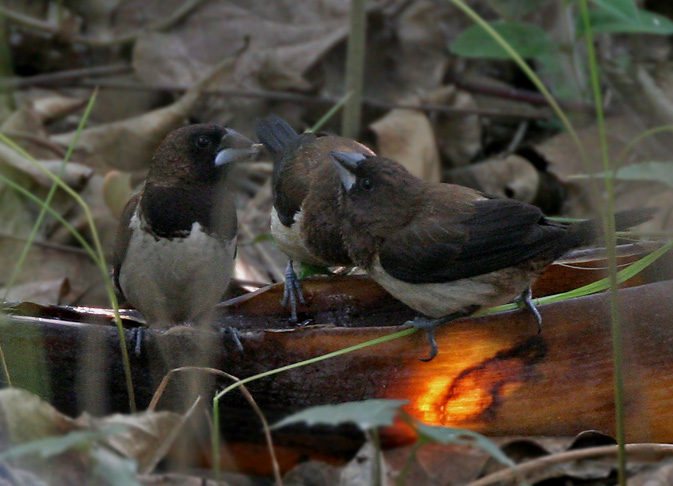
History
The species that gave rise to the Society Finch, members of the family Estrildidae, are native to southern Asia and closely related to Indian Silverbills, Tri-Colored Nuns and many others popular in the pet trade. The Society Finch most likely arose as a distinct species (or subspecies) in Japan, but there is also evidence that Chinese breeders had a hand in its development. The details are unclear.
A wide variety of color phases, such as fawn, white, piebald and black, have been produced. Certain strains vary in size, feather appearance and behavior, with some being harder to breed than others.
Sociable in the Extreme
Society Finch is an apt name, as these little birds are, indeed, quite “social”. Society Finches breed readily, and have highly-developed parental instincts. In fact, breeders and zoos routinely use them as foster parents for the chicks of other species. Fostering is useful in the case of abandoned chicks, and essential to a breeding technique known as “double-clutching”.
Double-clutching is used to obtain the maximum number of offspring from a pair of birds; breeders pull the first clutch (to be reared by foster parents), so that the female will produce another. Double-clutching is also well-known to zoo aviculturists…I successfully used this technique at the Bronx Zoo with Mauritius Pink Pigeons, which were fostered by Ring-Necked Doves (after a time, the Pink Pigeon chicks exceeded their foster moms in size, but the hard-working doves somehow managed to produce enough “pigeon milk” for their giant “guests”; I do recall that the doves consumed a great deal of food!).
Society Finches are quite accommodating, where breeding is concerned, in other ways as well. Two or more females will use a single nest if not discouraged, and groups will crowd into tiny nest boxes to roost. They will reproduce in mixed species aviaries, and have even been known to take over the nests of unrelated species and “kidnap” their chicks! Society Finches will also form same sex pairs, and have been cross-bred with unrelated species, including Star and Zebra Finches.
In common with the Zebra Finch, a willingness to reproduce under highly artificial conditions has rendered Society Finches as important laboratory subjects.
Captive Care
Society Finches will thrive in either indoor finch cages or outdoor aviaries. When properly acclimated and provided with a dry shelter, they are quite cold-hearty.
A good finch seed mix, comprised largely of canary seed and millet, will meet most of their needs. Pairs rearing chicks do best when provided with sprouts and egg food, but the young can also be successfully reared on seed alone. Grit and cuttlebone should always be available.
Breeding
 Standard finch boxes will be readily accepted as nest sites. Despite their eagerness to reproduce in captivity, most Society Finches will not tolerate nest inspections, and may abandon their eggs if disturbed. As they are usually excellent parents, breeding pairs are best left to their own devices.
Standard finch boxes will be readily accepted as nest sites. Despite their eagerness to reproduce in captivity, most Society Finches will not tolerate nest inspections, and may abandon their eggs if disturbed. As they are usually excellent parents, breeding pairs are best left to their own devices.
If several pairs are kept, care should be taken that multiple females do not use the same box. The eggs, 4-8 in number, are incubated for 14-18 days. Healthy females are very prolific, but producing more than 3-4 clutches per year may weaken them. The young fledge at day 20-21, and may reproduce when 3 months old. Ideally, however, Society finches should not be paired until 6-8 months of age.
Further Reading
Society Finches as Foster Parents
Photos: Black-Brown and other Color Phases
Video: Society Finches grooming and interacting
Keeping Nuns, Munias and other Society Finch Relatives
White-rumped Munia image referenced from wikipedia and originally by J M Garg
 That Bird Blog – Bird Care and History for Pet Birds
That Bird Blog – Bird Care and History for Pet Birds




This comment “The Society Finch most likely arose as a distinct species (or subspecies) in Japan, but there is also evidence that Chinese breeders had a hand in its development. The details are unclear.” is in error. The society finch (bengalese in UK) is merely a domesticated Lonchura striata swinhoei, the White-rumped munia. It’s not a hybrid of different mannakins.
Hello,
Thanks for your interest. When the article was written, the statement was correct per colleagues at the Am Museum of Natural History. Please forward any references you may have when time permits, thank you, Best regards, Frank
Wondering if you ever received any further info from Richard regarding the origin of the Society finch?
Fran
He may be referring to a different species…sorry, I haven’t looked into it any further.